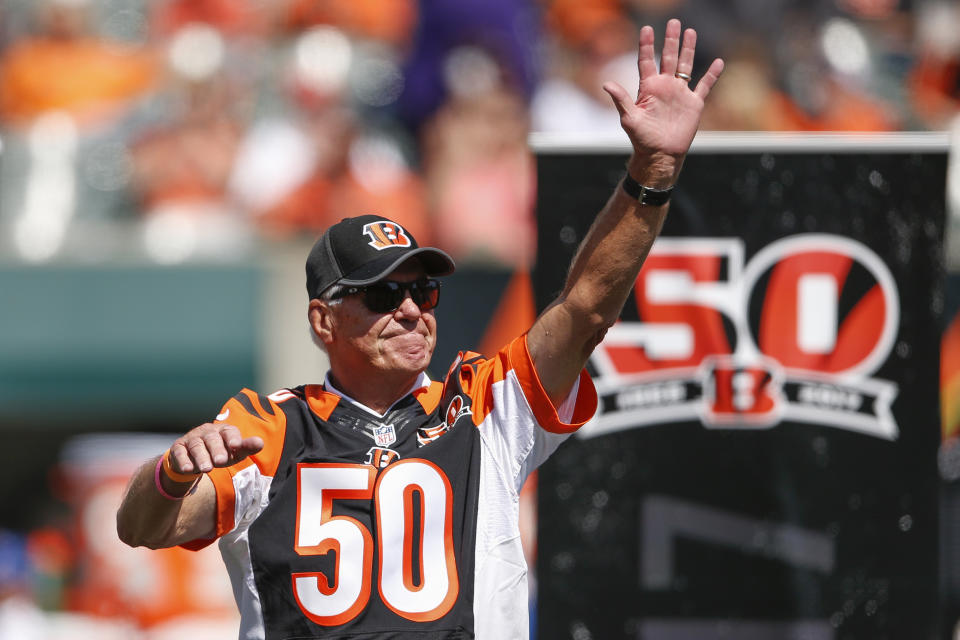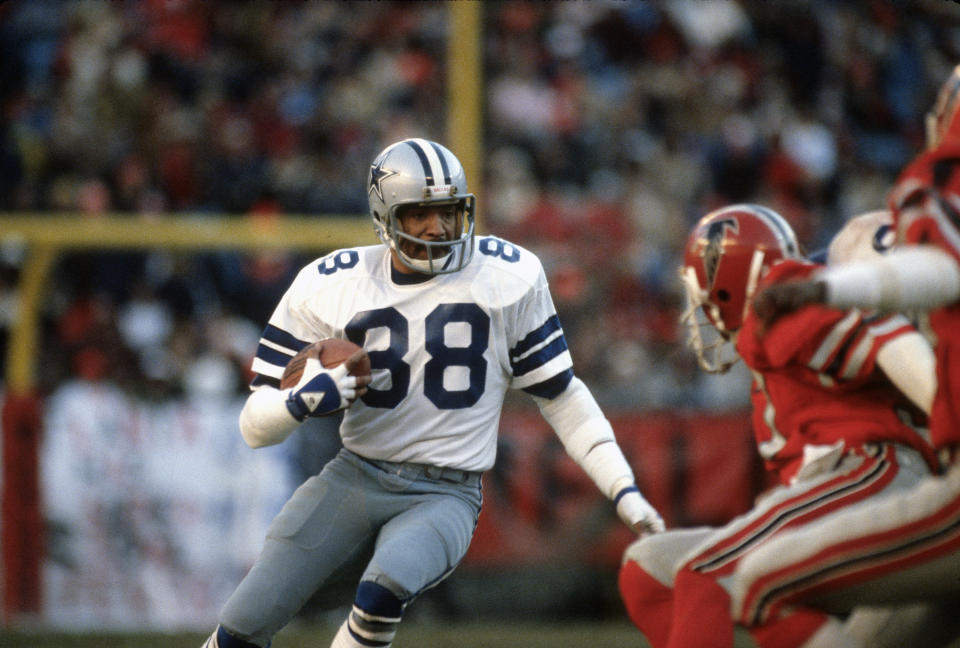2019 Pro Football Hall of Fame class: 7 seniors candidates to watch
The seniors committee will narrow the pool of 100 possible Hall of Fame candidates down to 15 by early August. From there, they’ll meet in late August to select one player who will be the senior committee’s nominee for the Class of 2019.
When the 48-man Hall of Fame voting committee convenes for its annual meeting before the 2019 Super Bowl, the entire body will conduct a vote on whether to include that nominee in the class.
(That vote is considered a formality, as it’s unlikely the entire voting committee would overrule a senior candidate due to the massive backlog of worthy senior candidates who need to be pushed through.)
Here’s a look at seven senior candidates in the running for induction next summer, with a take from Hall of Fame voter Rick Gosselin, who is also a member of the seniors committee:

Ken Anderson, quarterback
Team: Cincinnati Bengals (1971-1986)
His case: A former third-round pick out of Augustana College (Ill.), Anderson made four Pro Bowls and was named first-team All-Pro in 1981, the year he was also named the league’s Most Valuable Player. Was also named second-team All-Pro twice and led the NFL in passer rating four times and passing yards twice. Anderson was the first quarterback to complete 70 percent of his passes in a season. Finished his career with a 59.3 completion percentage for 32,838 yards, 197 touchdowns and 160 interceptions. Lost out on the 1970s and 1980s All-Decade Team to Terry Bradshaw, Roger Staubach, Ken Stabler, Joe Montana and Dan Fouts. All are in the Hall of Fame.
Why he didn’t make it: He never won a Super Bowl as a player, and for better or worse, quarterbacks are often judged by championships. He led the Bengals to Super Bowl XVI, and while he played well — setting then-Super Bowl records for completions and completion percentage — the Bengals still lost to the San Francisco 49ers 26-21.
Gosselin’s take: “He’s probably the best quarterback not to be in Canton.”
Jimbo Covert, offensive tackle
Team: Chicago Bears (1983-1990)
His case: The sixth overall pick in the 1983 draft out of Pittsburgh, Covert was an elite tackle during his eight-year career, earning two first-team All-Pro and two Pro Bowl nods. He played in 111 of 128 possible regular-season games. Super Bowl XX champion. All-Decade first-teamer for the 1980s at tackle with Anthony Munoz, and received that honor ahead of Gary Zimmerman of the Minnesota Vikings, who was voted into the Hall of Fame in 2008.
Why he didn’t make it: He has never been a finalist, which is curious since an All-Decade second-teamer, Joe Jacoby, has been a finalist three times. Perhaps his “short” career hurt; he played only eight seasons. There has also been a bias against offensive linemen through the years, and since those great Bears teams of the mid-80s were known more for their intimidating defenses, there’s a chance key offensive players on that team — aside from Walter Payton, of course — have been overlooked.
Gosselin’s take: “He’s the only player from the 80s All-Decade team to be omitted from the Hall of Fame, and Bill Parcells swears by him — he gave Lawrence Taylor fits.”
Cliff Harris, safety
Team: Dallas Cowboys (1970-1979)
His case: Went undrafted in 1970 out of Ouachita Baptist (Ark.). Nicknamed “Captain Crash” for his propensity to deliver big hits. Became a three-time first-team All-Pro and one-time second-team All-Pro selection. Made six Pro Bowls and was a member of the Super Bowl VI and Super Bowl XII champions. Played in five Super Bowls. First-team member of the NFL’s 1970’s All-Decade Team. Recorded 29 interceptions and 18 forced fumbles during his career and made a number of big plays in the playoffs, getting six interceptions and four forced fumbles in 21 postseason games.
Why he didn’t make it: Was a finalist only once, in his last year of eligibility, and some of that likely had something to do with his position, as safeties have historically been underrated by the committee.
Gosselin’s take: “Along with Drew Pearson, he’s the only player from the first-team All-70s not to be in.”

Drew Pearson, wide receiver
Team: Dallas Cowboys (1973-1983)
His case: Three-time first-team All-Pro and one time second-team All-Pro selection who made three Pro Bowls and was a member of the Super Bowl XII champions. Member of the NFL’s 1970’s All-Decade Team. Led the NFL in receiving yards in 1977 and finished with more receiving yards (7,822) than a handful of other Hall of Famers of his era, including Bob Hayes (7,414) of the Cowboys, Lynn Swann (5,462) of the Pittsburgh Steelers. Also had more receptions (489) than Hall of Famer Paul Warfield (427) of the Miami Dolphins. His receiving touchdowns (48) are comparable with Swann’s (51). First Cowboy receiver to wear number 88 and make it special, a tradition that was built upon by Michael Irvin and Dez Bryant.
Why he didn’t make it: Has never been discussed as a finalist, even though he was first-team All-Decade in the 70s ahead of Swann, a 2001 inductee. While he had more receptions than Warfield, the other All-Decade first-team receiver in the 70s, Warfield scored 37 more receiving touchdowns in his career.
Gosselin’s take: “How did Drew Pearson slip through the cracks and never get discussed as a finalist, when the two second-team All-Decade receivers are in?”
Ken Riley, cornerback
Team: Cincinnati Bengals (1969-1983)
His case: Sixth-round pick in 1969 from Florida A&M who was a turnover machine during his career, currently tied for fifth all time in interceptions with 65. That mark is second among corners, trailing only Hall of Famer Dick “Night Train” Lane. Was curiously never selected to a Pro Bowl (back when only coaches and players, not fans, selected the team) and was not an All-Decade Team member but was named All-Pro — a more prestigious honor, which was voted on by writers — three times (once as a first-teamer).
Why he didn’t make it: The Bengals’ other corner, Lemar Parrish — a flashy, terrific returner who has a compelling Hall case, himself — got most of the attention, making eight Pro Bowl appearances during a career that largely coincided with Riley’s. During the eight years they played together, the Bengals had a losing record only once.
Gosselin’s take: “Is the second leading rusher in? Yes. Is the second-leading passer in? Yes. Second-leading receiver? Yes. Second leading sacker? Yes. But why is the second-leading interceptor among corners not in?”
Johnny Robinson, safety/running back
Teams: Dallas Texans (1960-1962), Kansas City Chiefs (1963-1971)
His case: First-round pick of the Dallas Texans in the 1960 AFL draft. Spent his first two years as a running back before moving to defense in 1962, where he thrived. Six-time first-team All-Pro and two-time second-team All-Pro selection who made seven Pro Bowls and was a member of the Super Bowl IV champions. Member of the AFL’s All-Time team. Finished with 57 interceptions in 164 regular-season games, the most among active players and the third-most all time when he retired after the 1971 season.
Why he didn’t make it: During at least a portion of the time Robinson was eligible, there was a healthy bias against old AFL players, as the Hall of Fame committee included 14 NFL writers and eight AFL writers, a notion that is backed up by the fact that only nine of the 22 players on the AFL’s All-Time Team have been inducted.
Gosselin’s take: “He’s the best player in the AFL to not be in the Hall of Fame. I know Johnny Robinson belongs in the Hall of Fame, and there’s nothing no one can show me or tell me that is gonna sway my thinking.”
Duke Slater, offensive/defensive lineman
Teams: Milwaukee Badgers (1922), Rock Island Independents (1922-1926), Chicago Cardinals (1926-1931)
His case: Six-time All-Pro selection who was the first African-American lineman in NFL history and arguably the league’s best two-way lineman during his prime. The old football lineman axiom about “the best ability being availability” also applies here; Slater never missed a game over 10 seasons between the NFL and AFL and started 96 of 99 games. Was so good that he was the league’s only black player in 1927 and 1929, when team owners strictly enforced an unofficial ban on players of color. Went on to become only the first African-American member of the Chicago Superior Court after retirement and died in 1966 at the age of 67. Two-time Hall of Fame finalist (1970 and 1971).
Why he didn’t make it: He was essentially the Jackie Robinson of the NFL and was a two-time finalist but fell off the map as the Hall of Fame, which was established in 1963, struggled to squeeze 50 years of football into an initial induction period. As a result, some deserving players from the early period of the game slipped through the cracks.
Gosselin’s take: “He should definitely be in … that guy, he got screwed over in the process.”
More from Yahoo Sports:
• Former Steelers first-round pick Gabe Rivera dies
• Man calls cop after hard foul in pickup basketball
• Terrell Owens might be making a comeback in the CFL
• Cowboys DE Randy Gregory finally reinstated after 18-month suspension

